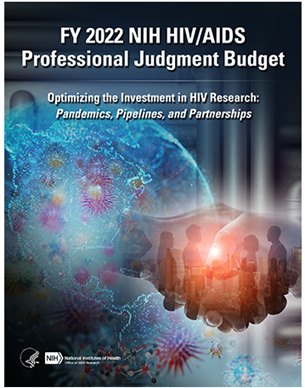Letters from the Director: Optimizing the Investment in HIV Research: Pandemics, Pipelines, and Partnerships

On June 5, 2021, the National Institutes of Health (NIH) Office of AIDS Research (OAR) joined colleagues around the world to commemorate the 40th anniversary of the landmark report that first recognized the syndrome of diseases later named AIDS. In the past 40 years, the NIH investment in HIV/AIDS research has helped turn a once-fatal disease into a manageable chronic illness and continues to lead the way against a global pandemic that has claimed more than 34 million lives.1 An estimated 1.5 million people still acquire HIV annually and nearly 700,000 people die.2
The OAR is authorized by the NIH Revitalization Act of 1993 to plan, coordinate, and evaluate HIV/AIDS research conducted or supported across the NIH. OAR develops the Professional Judgment Budget annually to identify opportunities for additional investment to accelerate critical research.
On August 24, the OAR released the Fiscal Year (FY) 2022 NIH HIV/AIDS Professional Judgment Budget: Optimizing the Investment in HIV Research: Pandemics, Pipelines, and Partnerships. The Professional Judgment Budget highlights accomplishments in HIV research during the prior year and estimates the funds needed to fully pursue scientific opportunities to advance progress in priority areas of science leading to an end to the HIV pandemic.
Over the decades, the NIH investment in HIV/AIDS research has positioned scientists and public health officials to meet the challenges of other infectious diseases, such as the current coronavirus disease 2019 (COVID-19) pandemic. At this time, to safeguard the historical investment in ending the HIV pandemic and ensure continued progress, the effect of the scale and scope of the COVID-19 pandemic on the HIV research enterprise must be assessed.
The OAR works collaboratively with local, state, and federal agencies, as well as community and public health partners, to leverage scientific discovery to prevent, treat, and eventually cure HIV. NIH investments in HIV and AIDS research over more than 30 years have produced groundbreaking advances in understanding the basic virology, immunology, and pathogenesis of HIV. Research discoveries led to the development and implementation of safe, effective antiretroviral therapy (ART) to extend the lifespan of people with HIV and to prevent HIV transmission and acquisition. Yet in the United States and globally, rates of new HIV infections continue to increase in some populations and remain unchanged in others, reflecting inequalities and health disparities by race, ethnicity, sex, gender, age, socioeconomic status, and geography—inequalities and disparities that are now shaping the outcomes of the COVID19 pandemic.
Understanding and addressing inequalities and health disparities are key to optimize the outcomes of decades of HIV/AIDS research and to realize the primary goal of Ending the HIV Epidemic in the U.S. (EHE) to reduce new HIV infections in the United States by at least 90 percent by 2030. At the NIH level, a new effort to end structural racism and racial inequities in biomedical research was launched through an initiative called UNITE. In the words of NIH Director Dr. Francis S. Collins, “NIH is committed to instituting new ways to support diversity, equity, and inclusion, and identifying and dismantling any policies and practices at our own agency that may harm our workforce and our science.”3
The Professional Judgment Budget is guided by the NIH Strategic Plan for HIV and HIV-Related Research and builds on the justification to Congress for the President’s Budget. For fiscal year (FY) 2022, the NIH HIV/AIDS Professional Judgment Budget requests $775 million in additional funds, a 25 percent increase in the HIV/AIDS research investment. Funding at this level will expedite NIH efforts to pursue emerging discoveries in focused areas of HIV pandemic research, enhance the pipelines of novel HIV prevention and treatment products, ensure a diverse pool of HIV investigators, and expand partnerships with stakeholders inside and outside of government to make greater inroads into mitigating inequalities and ending the HIV epidemic in the United States and globally.
To learn more, I encourage you to read the full FY 2022 NIH HIV/AIDS Professional Judgment Budget.
Maureen M. Goodenow, Ph.D.
Associate Director for AIDS Research and
Director, Office of AIDS Research
National Institutes of Health
1,2 Global HIV & AIDS statistics – Fact Sheet. Available at https://www.unaids.org/en/resources/fact-sheet.
3 Ending Structural Racism. Available at https://www.nih.gov/ending-structural-racism.
This page last reviewed on December 10, 2024

